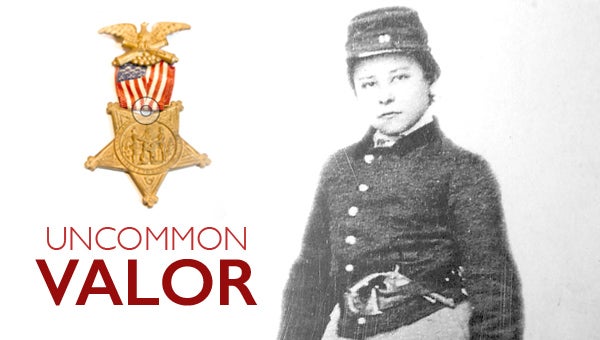Siege saw more than 100 awarded nation’s highest honor
Published 6:30 am Thursday, March 25, 2021
This article was first published in the March/April edition of Vicksburg Living. For more information on Vicksburg Living or how to subscribe to Vicksburg’s premiere magazine, call 601-636-4545.
A drummer boy, 14 years of age, and severely wounded and exposed to a heavy fire from the enemy, he persistently remained upon the field of battle until he had reported to Gen. W. T. Sherman the necessity of supplying cartridges for the use of troops under command of Colonel Malmborg.”
That citation accompanied the Medal of Honor Orion P. Howe received 33 years after his actions during the battle for the Stockade Redan on the first day of Maj. Gen.Ulysses S. Grant’s attempt to take Vicksburg.
The highest honor a member of the U.S. military can receive for distinguishing themselves in combat, the Medal of Honor was established in 1861. According to the Congressional Medal of Honor Society, 3,526 have been awarded to 3,507 recipients.
The most Medals of Honor in any American conflict — 1,523 — were awarded during the Civil War, with 122 awarded to Union sailors and soldiers for bravery during the fight for Vicksburg. Seventy-eight went to the volunteers of the “Forlorn Hope” for their efforts during the final May 22, 1863, assault on the Stockade Redan.
By contrast, 126 were awarded in World War I and 472 in World War II.
According to the Congressional Medal of Honor Society, the award was the idea of Iowa Senator James W. Grimes, who authored a bill authorizing the production and distribution of “medals of honor” to be presented to enlisted seamen and marines who “distinguish themselves by gallantry in action and other seamanlike qualities” during the American Civil War.
The Medal of Honor was initially created by the U.S. Navy in 1861 and named the “Medal of Valor.”
According to the Vicksburg National Military Park website, the Confederate States of America established the Confederate Medal of Honor on October 13, 1862, but because of a metal shortage, the medals were not minted for more than 110 years.
The U.S. Army began issuing a Medal of Honor in 1862 to men who distinguished themselves “conspicuously by gallantry and intrepidity” in combat with enemies of the United States.
Andrew Miller, lead park ranger at the Vicksburg National Military Park, said one reason for the difference in the number of Medals of Honor awarded since the Civil War is the interpretation of the criteria to receive it.
To receive the Medal of Honor, Miller said, “You would have to distinguish yourself conspicuously in battle, generally in a combat setting.
“Throughout time, our definition of what that means has changed … and that’s basically the interpretation of what gallantry is and what the conspicuous combat situation is,” he said.
For Vicksburg, Miller said, something like the assault of the Forlorn Hope or soldiers charging carrying their battle flag and maintaining that flag at the front of the regiment would have been acts worthy of a Medal of Honor.
“That’s because especially with the flag; the flag is the point the regiment rallies on,” he said. “That person holding that flag is the central focal point of every soldier as they’re charging, retreating, standing firm. It’s the point of honor, and that’s why when a flag bearer was killed or wounded and the flag was falling the first man would run up and grab it and continue to carry it on.
“It was vital to the survival of the regiment in a combat situation.”
Although the Medal of Honor for the Army was created and approved by Congress in 1862, the Army did not award the medals until 1863, and many were posthumously.
“It takes 30 years for a lot of these guys to start receiving their medals and many are receiving them at elevated ages,” Miller said. “It seems it took so long for the federal government to award these men their medals.”
Also, he said, medals were awarded for very unusual circumstances.
“If you captured a Confederate battle flag — and it didn’t matter how you did it; you could wrestle it from a flag bearer or picked it off the ground,” Miller said, “If you came back to the Union lines with that flag, you were generally given a Medal of Honor.”
Later, he said, many of those medals were rescinded when officials began to review how some of the men got their medals.
While the stories of all 122 Medal of Honor recipients during the Siege of Vicksburg cannot be told here, here are the stories of five Union recipients:
Orion P. Howe
Howe was a 14-year-old drummer boy in the 55th Illinois Infantry, which was part of the 5th Corps commanded by Maj. Gen William Tecumseh Sherman. Howe was the youngest Medal of Honor recipient of the Siege.
Howe, Miller said, enlisted in the 55th Illinois with his father, who commanded the regimental band and was the principal musician. Howe and his brother were drummers.
Musicians in a regiment were generally held in the rear when battle was imminent, Miller said. When the time came, they were stretcher-bearers who collected the wounded and the dead from the field.
Howe, however, wasn’t going to be left out of the fight when the 55th was ordered into battle on May 19, 1863, to assault the Stockade Redan complex along Graveyard Road.
When he saw his unit move, Howe, watching his regiment fix bayonets and push forward toward the Stockade Redan, left his father and brother and moved to the front, Miller said.
Howe found the 55th Illinois pinned down in a ravine by Confederate fire and running low on ammunition.
When the regiment’s commander called for volunteers to run through the fire and send word to get more ammunition to the unit, Howe volunteered with several other men. He was wounded and stumbled in front of Sherman and told Sherman to send cartridges to the 55th, telling Sherman, “The men are all out.”
“Sherman saw Howe had been wounded and asked him what was wrong. Howe said, ‘They shot me in the leg, sir, but I can go to the hospital, but send some cartridges right away,’” Miller said. “Sherman ordered him to the hospital, and as he left, Howe shouted out, ‘caliber 54.’ Sherman remembered that because it was an unusual caliber and it turned out to be the wrong caliber.”
One month after Vicksburg surrendered, Sherman remembered Howe and wrote a letter to Secretary of War Edwin Stanton commending Howe and seeking a commission for Howe as a midshipman at the U.S. Naval Academy at Annapolis, Md.
Howe later returned to his unit and was discharged as a corporal.
After the war, he became a midshipman, graduating from the Naval Academy in 1870 and serving two years in the Navy.
He later graduated from New York University and became a dentist. He was practicing in a town in Nebraska in 1896 when he learned he was receiving the Medal of Honor, 33 years to the date of his actions at the Stockade Redan.
“He was an amazing young man and when we get school groups to the park, we always talk about Orion P. Howe. We tell them the story of Howe and how he was 14 years old and the things he accomplished as a 14-year-old and sort of build on that as somebody to look up to.”
Martin McHugh
A seaman on the gunboat Cincinnati.
“As Grant’s army is starting to move around and envelop the entire city of Vicksburg in the latter part of May 1863, we have the gunboats on the river,” Miller said. “The Cincinnati comes around the bend of the DeSoto Peninsula and gets a little too close to the river battery below Fort Hill.
When the gunboat begins to engage the battery, other Confederate batteries get involved and some of the cannons’ shells penetrate the Cincinnati’s armor and the boat starts to sink.
During the battle, McHugh hauls the boat’s colors.
“He nails them to the mast, essentially,” Miller said. “Essentially they’re (the crew) going to stay with the ship as the gunboat was sinking.”
During the battle, McHugh showed “conspicuous valor,” going from gun to gun and remaining calm.
The Cincinnati sank but was later refloated by the Union Navy and repaired.
Patrick McGuire
McGuire was a private in the Chicago Mercantile Battery. The battery fought at the battle of Champion Hill and one of its guns was cited as killing Brig. Gen. Lloyd Tillman during the Confederate retreat.
On May 22, Miller said, the Chicago Mercantile Battery fired on the Texas Lunette during an assault on the fortification.
“Realizing that they (the assault) needed a little bit of help, the battery’s commander, Capt. Patrick White, asked for volunteers, one of which was Patrick McGuire, an Irish immigrant who was with the battery.”
The volunteers took a small, 6-pounder cannon and rolled it down the ravine toward the lunette. They got the gun over the next ravine with the help of some volunteers from a Wisconsin unit and placed the gun to the lunette’s embrasure, or opening. They then fired the cannon directly inside the lunette, killing and wounding Confederate soldiers.
“The gun is there throughout the assault, which began at 10 o’clock in the morning and fizzled out at night,” Miller said. He said the gun was left at the fortification and was later recovered by Union troops.
“McGuire carried that gun up the hill and to that embrasure and works the gun throughout the battle until the scenario became too hot for them and they were forced to retreat.
McGuire received his Medal of Honor in 1895.
Menomen O’Donnell
O’Donnell was a lieutenant in the 11th Missouri who participated in the May 22 assault.
“He volunteered and joined the color guard,” Miller said. “He saw the men were wavering and took the colors of the regiment and placed the colors on the parapet. He voluntarily placed himself in the ranks of the assaulting column and rode into the enemy’s works.”
O’Donnell was the only officer in the assault and was wounded. He was also cited for bravery at the battle of Fort DeRussey in 1864 in Louisiana. He received his medal in 1897.
Jacob H. Overturf
Overturf was a private in the 83rd Indiana, which was part of Sherman’s 5th Corps that assaulted the Stockade Redan on May 19 and again on May 22 as part of Grant’s attempt to make a big push and capture Vicksburg with a massive assault on the Confederate lines.
There was a large, deep ditch in front of the Stockade Redan that many Union troops were using for cover from the Confederate guns, Miller said.
“That was an obstacle that needed to be bridged over and allow the assaulting troops to not fall into the ditch, but climb over it and get up the hill and run into the Confederate fort,” Miller said.
Volunteers were called to fill the ditch with logs, ladders and bundles of sticks wrapped together to make it a level surface so assaulting troops could take the fort.
“So, 150 volunteers — when they called for volunteers, twice as many stepped forward to offer their services, and when they received the volunteers they needed, you needed to be unmarried,” Miller said.
The idea, he said, was that if a volunteer were killed, he would not be leaving behind a widowed wife and children.
Overturf and the other volunteers grabbed the items. The assault was preceded by an artillery barrage across the Union front. The troops advanced and the volunteers of the Forlorn Hope moved forward into strong Confederate fire.
“Overturf and his comrades make it to the ditch, they drop their stuff into the ditch, they turn around, and there’s no assaulting force behind them,” Miller said. “The assault force that was to immediately follow them up never got the message and was delayed.”
Sherman, watching the events take shape and the fate of the Forlorn Hope, Miller said, “Was fuming. He was incredibly upset and orders the federal soldiers forward; they take immense casualties and the assault across the line fails.”
After the failure of the assault, Grant then decided to take Vicksburg by siege.







